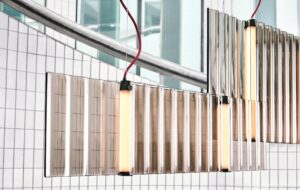Get a curated collection of design and architecture news in your inbox by signing up to our ICON Weekly newsletter
Built by Stockholm-raised architect Fredrik Nilsson and his wife, writer Keshni Kashyap, the pair built a small-footprint urban treehouse inspired by Scandinavian modernism
 Photography by Caitlin Atkinson
Photography by Caitlin Atkinson
Words by Harriet Thorpe
Raised in Stockholm and calling Los Angeles home for more than 20 years, architect Fredrik Nilsson decided it was time to cast down some roots in his local neighbourhood of Echo Park. Nilsson and his wife, Keshni Kashyap, a Singapore-born, Indian-American TV writer, were ready for a home that could express their personal cultures and way of life together as a family with their young daughter.
Originally seeking a house with good bones to renovate, after time scouring the market (‘Everything was flipped and extremely un-inspirational’), Nilsson happened upon a ramshackle cottage on a small neglected site, which he decided to mostly demolish to make way for their unique, modern home – an ‘urban treehouse’ of two stacked timber volumes clad in raw-oiled cedar, flooded with daylight and set in a leafy oasis landscaped by neighbour David Godshall of Terremoto.
While the work of Scandi architectural greats Gunnar Asplund, Sigurd Lewerentz and Alvar Aalto defined Nilsson’s architectural training in Stockholm, his career in Los Angeles has been informed by the likes of Schindler and Neutra.’
 Photography by Caitlin Atkinson
Photography by Caitlin Atkinson
My first job interning for Wingårdhs / Wilhelmsson (now Wingårdhs) involved travelling around Stockholm sketching, photographing and studying the greats, including Peter Celsing, whose bold, clear form architecture has always been inspiring,’ says Nilsson. ‘Today I find myself inspired by local LA architects, who in turn are clearly inspired by Scandinavian architecture – the architectural trip has gone full circle.’
It’s a relationship that was captured in the recent LACMA show, Scandinavian Design and the United States, 1890–1980, with exhibition design by his ‘contemporary inspiration’ LA architect Barbara Bestor who captures the bohemian eclecticism of the city in her work. ‘Both Scandinavian and early-to-mid-20th-century Californian domestic modern architecture have a clear, almost industrial effectiveness in their articulation. Nothing is frivolous, all moves have a functional purpose and in the successful examples, an artistic solution.’
Inspired by houses such as the Eames House, Horatio Court by Irving Gill, Aalto’s Villa Mairea, Ralph Erskine’s Villa Erskine and Gunnar Asplund’s Stennäs, he balanced the ‘search for light’ common to Scandinavian modernism, with the blurred boundaries between indoor and out as seen in Californian modernism. For example, large windows to the bedrooms on the ground floor overlook the garden and bring in the morning light. Upstairs the living spaces are flooded with light from picture and floor-to-ceiling windows, while a balcony and roof deck open up views of the city and nature.
 Photography by Caitlin Atkinson
Photography by Caitlin Atkinson
The interiors evoke Kashyap’s love of colour and warmth, and the diversity and creativity of life in LA. There’s lots of exposed timber finishes: oak panelling, white-washed beech, more oiled cedar for the staircase. Bright and cool blue tiles by Puzzle and Rombini bring flavour, while delicate and bold patterned wallpaper by Hygge & West bring personality.
Organic mid-century furniture pieces include a grasshopper floor lamp by Swedish designer Greta Magnusson; a vintage leather armchair by Finnish brand Asko; a Lamino lounge chair and footstool by Yngve Ekström for Swedese. Plus there’s plenty of personal pieces – restored dining chairs by Carl Malmsten for Stolab, inherited from Nilsson’s grandmother; a flea market coffee table from Palm Springs; and lights designed by neighbour and friend Brendan Ravenhill.
Yet what really completes the scene is how the house invites moments of ‘mysigt’, the Swedish version of hygge. ‘Like hygge, mysigt is a sense you get when feeling safe from the weather, warm and cosy,’ says Nilsson. ‘It can be found in places that are proportional in size to the human body, like the reading nook in the master bedroom, or on the kitchen deck surrounded by plants protected from the harsh Southern California sun yet still connected to the neighbourhood and the verdant Echo Park hills.’















